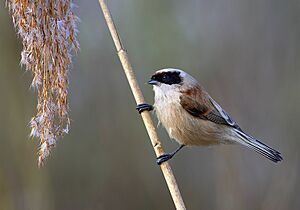Eurasian penduline tit facts for kids
Quick facts for kids Eurasian penduline tit |
|
|---|---|
 |
|
| in Olomouc, Czech Republic. | |
| Conservation status | |
| Scientific classification | |
| Genus: |
Remiz
|
| Species: |
pendulinus
|
 |
|
| Range of R. pendulinus Breeding Resident Passage Non-breeding | |
| Synonyms | |
|
|
The Eurasian penduline tit or European penduline tit (Remiz pendulinus) is a small passerine bird. A passerine is a type of bird that perches, like a sparrow. This bird lives across a wide area of western Palearctic, which includes parts of Europe and Asia.
Some of these birds travel south for winter, especially those from the northern areas. Others stay in the same place all year. The places where this bird lives and raises its young grew bigger in the 1980s and 1990s. Its winter homes also spread, reaching as far south as northern Morocco.
This bird builds a very special hanging nest. People in Central Europe used to even use these nests as children's slippers!
Contents
How Scientists Name the Penduline Tit
Scientists give every living thing a unique name. This helps everyone know exactly which animal they are talking about. The Eurasian penduline tit was first officially described in 1758. A Swedish scientist named Carl Linnaeus gave it the name Motacilla pedulinus.
Later, in 1819, a Polish zoologist named Feliks Paweł Jarocki created a new group, or genus, called Remiz. The penduline tit was then moved into this group. The word Remiz is actually the Polish name for this bird. The second part of its scientific name, pendulinus, comes from a Latin word meaning "hanging down." This refers to its amazing hanging nest.
Different Types of Penduline Tits
Scientists have found four slightly different types, or subspecies, of the Eurasian penduline tit:
- R. p. pendulinus: Found from Europe to the Ural Mountains, Caucasus region, and western Turkey.
- R. p. menzbieri: Lives in southern and eastern Turkey, Syria, Armenia, and northwest Iran.
- R. p. caspius: Found in southwest Russia and northwest Kazakhstan.
- R. p. jaxarticus: Lives from the eastern Ural Mountains to western Siberia and northern Kazakhstan.
What Does the Penduline Tit Look Like?
This is a small bird, about 10 to 11.5 centimeters (4 to 4.5 inches) long. It has a thin, pointed beak and a fairly long tail. Its head is light grey, and it has a black "mask" that goes across its eyes. The back of the bird is a chestnut brown color.
Male and female penduline tits look very similar. However, the male usually has a wider black mask. His back also tends to be a bit more reddish-brown.
Life Cycle and Nest Building
Penduline tits start laying their eggs from late April to early July. They build a very special nest that hangs from thin branches. These branches often belong to trees like willow, elm, or birch. The nest is usually found hanging over water. Sometimes, they even hang their nests between two or three tall reeds, just about a meter above the water.
The nest is shaped like a large pouch and hangs freely. It is about 25 cm (10 inches) tall and 17 cm (7 inches) wide. The birds make it from plant fibers, grass, animal hair, and wool. It has a small tube-shaped entrance on one side. Both the male and female birds work together to build the nest. This building process takes about 20 days.
Eggs and Chicks
The female lays one egg each day. A clutch usually has 6 to 8 white eggs. Each egg is about 16.2 x 10.7 mm (0.6 x 0.4 inches) and weighs about 0.95 grams. The eggs start to hatch after about 14 days. Either the male or, more often, the female bird sits on the eggs to keep them warm. Both parents usually do not sit on the eggs together.
All the chicks hatch at about the same time. Once they hatch, either the male or the female parent takes care of them. It is rare for both parents to raise the chicks together. The young birds are fed insects, like larvae, and spiders. The chicks are ready to leave the nest when they are about 22 days old. Sometimes, the parents try to have a second group of chicks, but this does not happen very often.
What Do Penduline Tits Eat?
The Eurasian penduline tit mostly eats insects and spiders. However, they also enjoy eating seeds, especially those from willow trees. They usually look for food in trees. But they also search for food in reeds. They can pick insects right off the reed stems. They also eat the seeds from the top of the reeds.
When eating from reeds, they use one foot to hold onto the reed. With the other foot, they pull out clumps of seeds from the seed head.
How Are Penduline Tits Doing?
The penduline tit lives across a very large area. This area is estimated to be between 1 and 10 million square kilometers (0.4 to 3.8 million square miles). In Europe alone, there are an estimated 420,000 to 840,000 individual birds.
Scientists believe that the number of these birds is actually growing. Because of their large range and increasing population, they are not considered to be in danger. The IUCN Red List says they are of "Least Concern." This means their population is healthy and not declining quickly.




